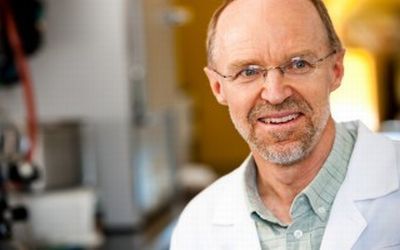Breakthrough Drug Will Take the Bite Out of Malaria
A powerful new drug to treat malaria the invention of a University of Nebraska Medical Center College of Pharmacy researcher -- will help take the bite out of malaria. In the United States, a mosquito bite seems harmless, but in developing countries it means more than 655,000 deaths a year mostly in children.


Jonathan Vennerstrom, PhD.
A powerful new drug to treat malaria the invention of a University of Nebraska Medical Center College of Pharmacy researcher -- will help take the bite out of malaria. In the United States, a mosquito bite seems harmless, but in developing countries it means more than 655,000 deaths a year mostly in children.
The new drug, Synriam, is considered a breakthrough, as traditional drugs are proving increasingly ineffective against the deadly malarial parasite because of acquired resistance to available drugs. Taken as a tablet once a day for three days, its more effective, cheaper, has fewer side effects and does not have to be taken with food.
From 2000 to 2010, Jonathan Vennerstrom, PhD, a professor at the UNMC College of Pharmacy, led an international team that created the drug compound that led to the development of Synriam. Developed by Ranbaxy Pharmaceuticals Limited, the medication now is approved for treatment in adults in India. The company also is working to create a childrens formula and make the drug available in Africa, Asia and South America.
Vennerstrom and his team received more than $12 million in grants from Medicines for Malaria Venture (MMV), a non-profit organization in Geneva, Switzerland. He has been studying malaria for more than 25 years. The research team included scientists at the Swiss Tropical and Public Health Institute in Switzerland and Monash University in Australia. MMV receives about 60 percent of its funding from the Bill and Melinda Gates Foundation.
With more than 200 million cases of malaria each year, the potential impact this drug could have on saving and improving lives worldwide is significant, Vennerstrom says. Thats been our goal and now we are at the finish line. We were very fortunate to receive the support for our project from MMV, he said. It is always unpredictable whether or not a drug candidate will be successful.
Tim Wells, MMVs chief scientific officer, said the completion of a phase III study in Indian adults and the approval of the combination by the Indian regulators was a major milestone. We look forward to more data from patients in Africa and from studies with children, since this is where the vast majority of the disease is, he says.
Courtney Fletcher, PharmD, dean of the UNMC College of Pharmacy, said another benefit of arterolane, the key component in the new drug invented by Vennerstrom, is its a synthetic. This is an importance advance in antimalaria drugs. Since its a synthetic drug, it doesnt depend on the availability of a natural plant source like some other antimalarials, which also makes it less expensive.
Vennerstrom and his team also have developed a second drug candidate that might be even more superior than the first. It currently is being tested in phase II clinical trials by MMV in Bangkok, Thailand.
This drug candidate seems to stay in the body longer, and therefore it may be possible to use a single dose instead of three doses, Vennerstrom says. We all forget to take our medications from time to time, so compliance becomes much easier when you have a single-dose drug.
As a child of missionary parents working in Ethiopia, Vennerstrom took medications to prevent malaria.
From the Derby to the Decontam Room: Leadership Lessons for Sterile Processing
April 27th 2025Elizabeth (Betty) Casey, MSN, RN, CNOR, CRCST, CHL, is the SVP of Operations and Chief Nursing Officer at Surgical Solutions in Overland, Kansas. This SPD leader reframes preparation, unpredictability, and teamwork by comparing surgical services to the Kentucky Derby to reenergize sterile processing professionals and inspire systemic change.
Show, Tell, Teach: Elevating EVS Training Through Cognitive Science and Performance Coaching
April 25th 2025Training EVS workers for hygiene excellence demands more than manuals—it requires active engagement, motor skills coaching, and teach-back techniques to reduce HAIs and improve patient outcomes.
The Rise of Disposable Products in Health Care Cleaning and Linens
April 25th 2025Health care-associated infections are driving a shift toward disposable microfiber cloths, mop pads, and curtains—offering infection prevention, regulatory compliance, and operational efficiency in one-time-use solutions.
Phage Therapy’s Future: Tackling Antimicrobial Resistance With Precision Viruses
April 24th 2025Bacteriophage therapy presents a promising alternative to antibiotics, especially as antimicrobial resistance continues to increase. Dr. Ran Nir-Paz discusses its potential, challenges, and future applications in this technology.